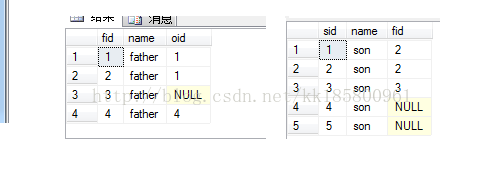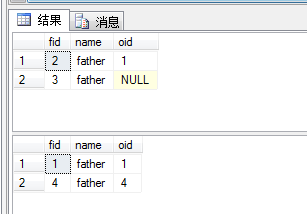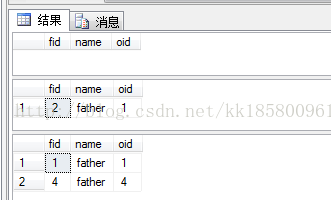SQL查询:慎用 IN 和 NOT IN
点击关注上方“SQL数据库开发”,
设为“置顶或星标”,第一时间送达干货 SQL专栏 SQL基础知识第二版
SQL高级知识第二版
作者:薛定谔的DBA
blog.csdn.net/kk185800961/
今天突然想到之前在书上看到的一个例子,竟然想不起来了.
于是翻书找出来,测试一下.
-- drop table father,son
create table father(fid int,name varchar(10),oid int)
create table son(sid int,name varchar(10),fid int)
insert into father(fid,name,oid)
values(1,'father',5),(2,'father',9),(3,'father',null),(4,'father',0)
insert into son(sid,name,fid)
values(1,'son',2),(2,'son',2),(3,'son',3),(4,'son',null),(5,'son',null)
select * from father
select * from son

in和exists差异开始测试吧,现在测试使用in、not in 可能带来的“错误”。之所以错误,是因为我们总是以自然语言去理解SQL,却忽略了数学中的逻辑语法。不废话了,测试看看吧!
【测试一:in子查询】
--返回在son中存在的所有father的数据
--正确的写法:
select * from father where fid in(select fid from son)
--错误的写法:
select * from father where fid in(select oid from son)

说明:
两个查询都执行没有出错,但是第二个tsql的子查询写错了。子查询(select oid from son)实际单独执行会出错,因为表son不存在字段oid,但是在这里系统不会提示错误。而且father表有4行数据,所有子查询扫描了4次son表,但是第二个查询中,实际也只扫描了1次son表,也就是son表没有用到。
即使这样写也 不会出错:select*fromfatherwherefidin(selectoid)
这个查询的意思是,表father中每行的fid与oid比较,相同则返回值。
实际查询是这样的:select * from father where fid = oid
测试一中,fid in(select fid from son)子查询中包含null值,所以 fid in(null)返回的是一个未知值。但是在刷选器中,false和unknown的处理方式类似。因此第一个子查询返回了正确的结果集。

【测试二:not in子查询】
--返回在son中不存在的所有father的数据
--错误的写法:
select * from father where fid not in(select fid from son)
--错误的写法:
select * from father where fid not in(select oid from son)
--正确的写法:
select * from father where fid not in(select fid from son where fid is not null)

说明:
查看select fid from son,子查询中有空值null,子查询中的值为(2,3,null),谓词fid in(2,3,null)永远不会返回false,只反会true或unknown,所以谓词fidnot in(2,3,null)只返回not true 或not unknown,结果都不会是true。所以当子查询存在null时,not in和not exists 在逻辑上是不等价的。
总结
In 或 not in在SQL语句中经常用到,尤其当子查询中有空值的时候,要谨慎考虑。因为即使写了“正确”的脚本,但是返回结果却不正确,也不出错。
在不是很理解的情况下,最好使用 exists和 not exists来替换。而且exists查询更快一些,因为只要在子查询找到第一个符合的值就不继续往下找了,所以能用exists就用吧。

数据前线
后台回复关键字:1024,获取一份精心整理的技术干货 后台回复关键字:进群,带你进入高手如云的交流群。 推荐阅读
